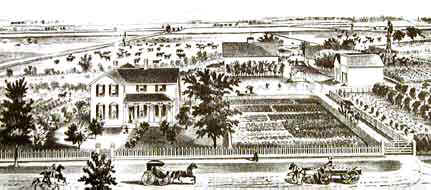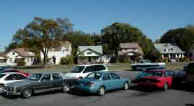|
Site Of Old Schweiter Farmstead
Filled With Bungelows, Park
 |
The sketch to the left depects the Henry Schweiter residence and farm, which was located on the southeast corner of Hydraulic and Lincoln. The view is looking east, and the original streambed of Chisholm Creek can be seen just behind the barn. Much of the farm later was dedicated to the city as the present North Linwood Park. |
Schweiter was born in Switzerland in 1844 and came to Topeka in 1868 where he became a carpenter. In January 1870, he came to Wichita and stopped his covered wagon on the edge of the Arkansas Valley, now College Hill, and decided that this was where he wished to settle. He brought less than $1,000 with him, but by the time he died in 1925 he was a millionaire and one of the most respected men in the city.
According to the Beccy Tanner writing in the Wichita Eagle, Oct. 29, 1992, "In the beginning, Schweiter worked as a contracting carpenter and helped work on some of Wichita’s early buildings. Later, Schweiter along with John Davidson went into the lumber business, and they became owners of the city’s first lumberyard. In 1871, he traded the store and lot for a quarter-section of land south of the city... Schweiter built an icehouse on Chisholm Creek, which meandered across his land. By 1876, his ice business had become so thriving that he built a huge icehouse on Chisholm Creek north of Third Street...By this time, Schweiter’s wealth and influence in the city were considerable. In 1886, he opened a steam-powered railway Schweiter’s Rapid Transit Line that started at Emporia and Douglas, ran south on Emporia to Kellogg, east to Hydraulic and from there followed a diagonal path to within a block of Hillside. That line is now called George Washington Boulevard."
| During Wichita’s boom in the 1880s, Schweiter purchased the northeast corner property at Main and Douglas for $75,000. In 1910, he built the 10-story Schweiter Building on the property. He also built a number of small houses in the south part of the city and sold them to young families almost at cost and on easy terms because he wanted them to have a chance to own their own homes. At right is a photo taken from the same general perspective as the sketch above. |  |
He hired an English landscape gardener to design and work on a picnic area that later became Linwood Park. A variety of trees not native to the area such as beech, Japanese gingko and linden were planted. In 1887, Schweiter gave the area roughly bounded by Lincoln, Harry, Hydraulic and Grove Streets to the City of Wichita. This was prior to the establishment of Riverside Park, and it was the best-landscaped city park at the turn of the century.
The farm remained in production until the 1940s when the Schweiter addition was developed.